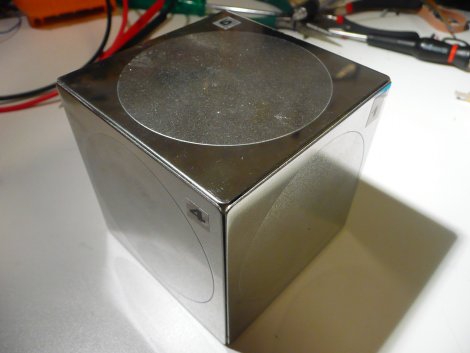
Most of the dice related hacks we run into have to do with pseudo random number generation, but today we saw something different. This sleek looking jumbo die is actually a prize holding box opened by a secret sequence of rotations. Using an accelerometer and an ATmega 328 with a sub-micro servo to control the locking mechanism. Worried about the batteries going flat and losing your treasure indefinitely? Good news! The batteries are accessable without giving away the secret inside.
It also turns out that this is an update to an earlier project from the same laboratory, so be sure to check that out as well to see where this build came from. Code is available for anyone looking to make their own, as well as a useful parts list.
[via Hacked Gadgets]














psuedo?
Incredible, every single post on HaD has at least a typo!
Cool project, but does it give a hint to help you get the prize? Or it’s more like a safe?
That’s fun =) Like those silly puzzle boxes but with more… geek-iness.
Love FUN innovative uses for technology, instead of ‘how can we kill people better’ applications.
And Faelenor… you could just appreciate the article… we’re not writing an English paper here.
Let people post what they want Setax. There are to many rude people already in the world
Setatx: Since when only whatever you mean by “English paper” has to be written with correct English? So, what you say is that a journalist can write that 2+2 = 3 because he’s not writing a math paper? Correct language is the base of everything. It’s not acceptable to have typos on a site like this, especially considering that spell checkers are widely available.
I like the idea. And it looks good, too. One thing I wonder is, whether an accelerometer isn’t a bit over the top. I seem to remember some kind of non-toxic mercury switch the was featured on HAD.
“Correct language is the base of everything.”
Wrong. Communications are the base of everything.
2+2=3 is a failure at communicating that when you have two units on one place and two on another you have a total of four units.
“psuedo random number generation” is, despite the typo, pretty effective at communicating that we’re talking about numbers being generated pseudo-randomly (for anyone who knows enough english to be browsing this site). So yes, that’s an acceptable typo. An inacceptable typo would be for ex. a miswritten part number (because it would fail to communicate what part they’re talking about).
Moreover typos are sort of HaD’s signature now. It just wouldn’t be HaD without them. :-)
As for the project, no comments, other than I’d have probably used a small rechargeable Li-Ion with a mini-USB port.
Just to give it a modern feeling. AA batteries (especially in groups of 4) make me nostalgic. :-(
@Faelenor: It’s more like a safe. You can give it as a present, and you can make the code as difficult and the clues as vague as you want.
@TomF: Most mercury switches are 1 dimensional, while the dice needs 3D. The original dice used a mechanical 3D tilt sensor, but this was way too big for d’Icey.
@Whoever: Noted for future redesign… Nostalgic :-)
Reminds me of those wooden trick boxes, Knock Box and Spin Box. You had to spin it around and tap edges on the table in a certain order before the box would open… and its done entirely out of creative channeling in the wooden lid, no batteries required.
“…actually a prize holding box opened by a secret sequence of rotations”
Surely I’m not the only one to be thinking of Hellraiser :)
This would be an excellent addition to add another layer of complexity to your reverse-geocache puzzle box.
And, as much as I don’t want to:
Faelenor, you succeed at hypocrisy.